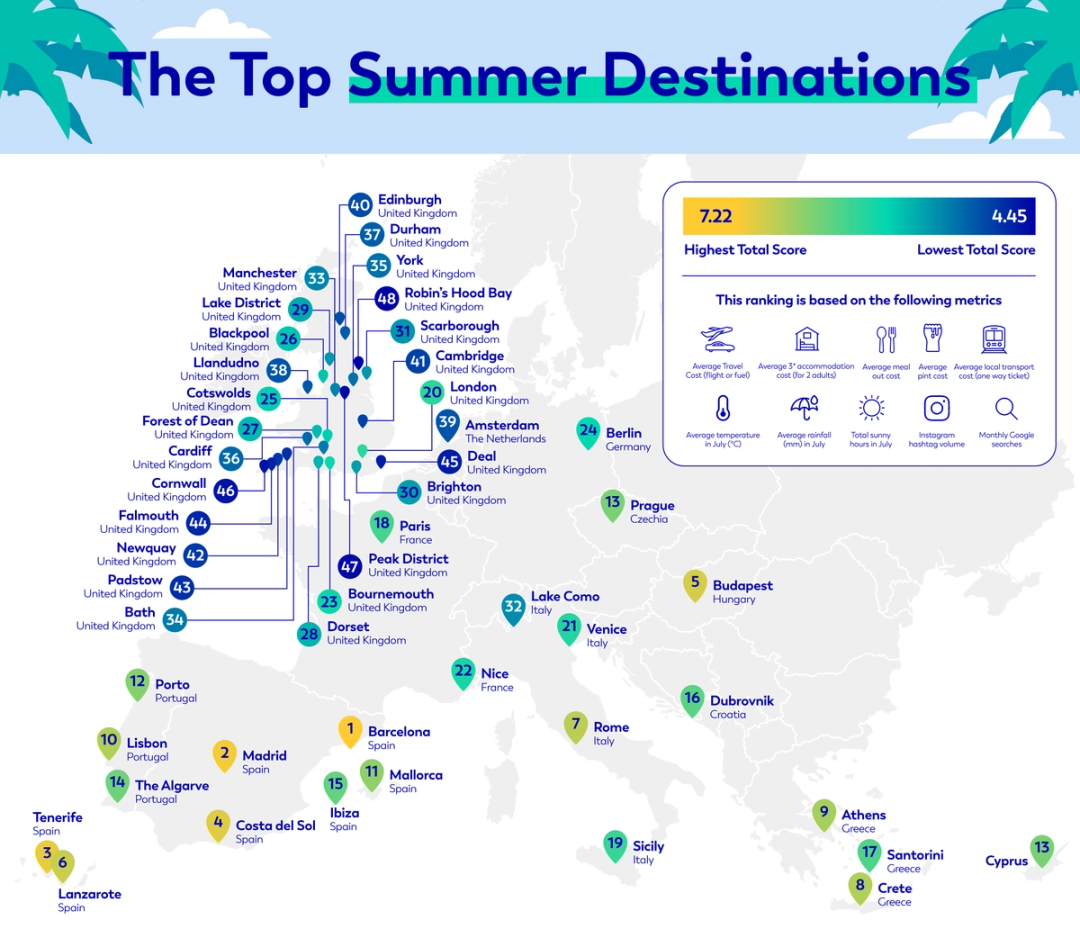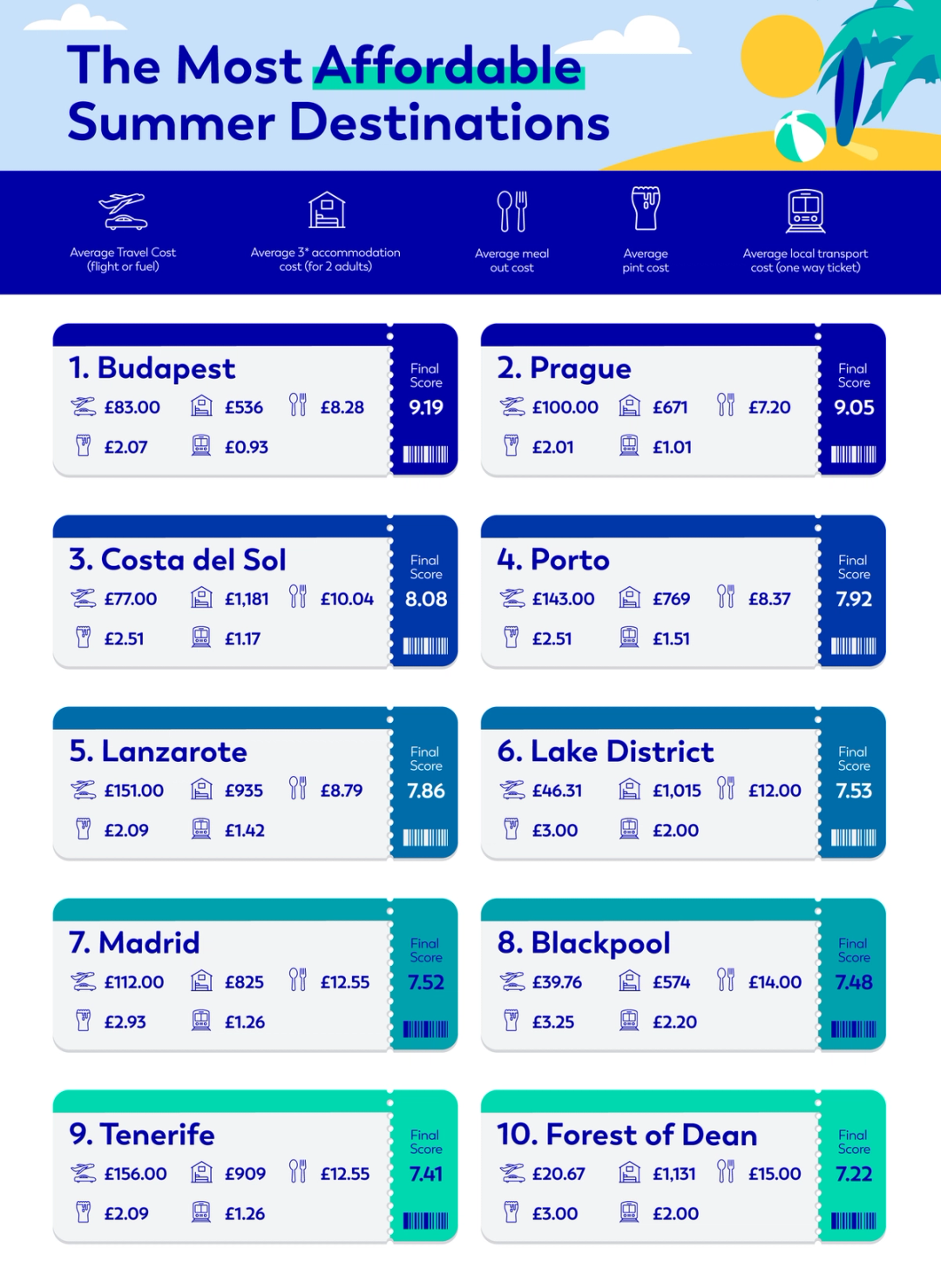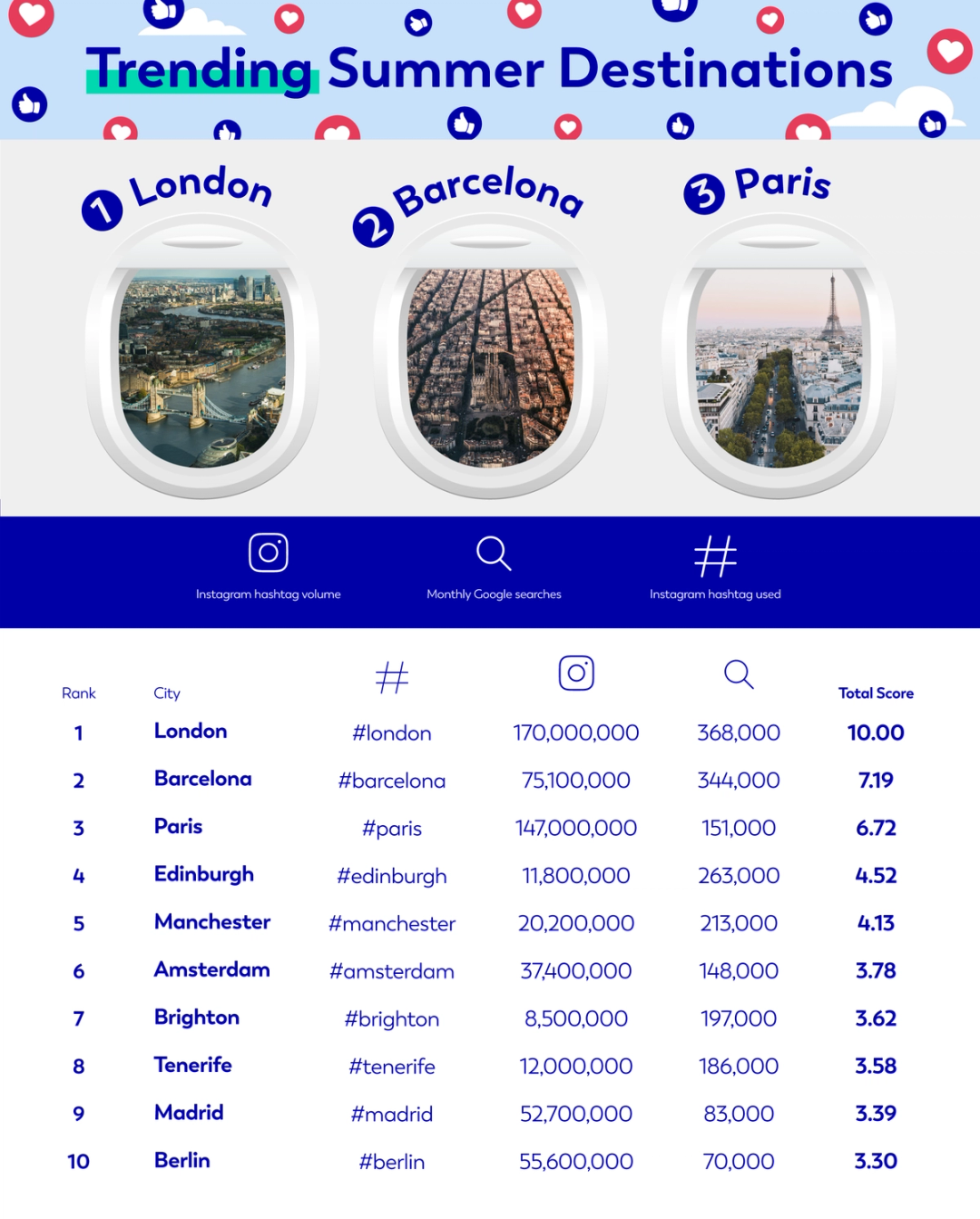In this article
Summer Destinations: UK vs Europe
Discover where your money stretches further for summer holidays in 2025.

As UK households take a closer look at their spending, many people are rethinking how they holiday. With nearly half (48%) of the UK cutting back on the number of holidays, or skipping them altogether, the British holiday has evolved in line with the cost of living.
To help budget-conscious travellers make informed choices, we compared the cost of a week away to for two adults 49 popular holiday spots across the UK and Europe. We looked at a range of real-world costs from return travel flights per person and fuel costs, to accommodation for two adults, meals, and drinks, as well as the average weather, social media popularity, and local transport costs.
Our research found that certain trips abroad could actually cost less than staying closer to home. In fact, a week-long trip to Scarborough could cost over £1,700, while the same length break in Budapest, including flights and accommodation, comes in at just over £600.
Everyone’s financial situation is different, but this guide offers helpful insights into where your money could go further this summer, as well as tips on how to plan a cost-conscious break without compromising on the experience.
Which locations are best overall for experience and expenses?
When we analysed popular summer destinations across the UK and Europe, one thing became clear: all of the top ten best locations were in Europe. Not a single UK destination made the top ten, suggesting that heading abroad may offer better value for money than staying closer to home.
Barcelona
Barcelona leads the pack with its blend of sunshine, city buzz, and seaside views. It offers a reliably warm July with temperatures averaging at 22°C and over 300 hours of sunshine, making it ideal for both exploring and unwinding. Weekly accommodation costs are relatively high at £1,136 for two adults, but affordable flights (£72 return per person) help keep the overall spend in check. It's also one of the most searched and shared destinations online, with more than 75 million hashtags on Instagram and over 340,000 monthly Google searches.
Madrid
Spain’s capital ranks just behind Barcelona, offering better hotel prices (£825 per week) and warmer July temperatures (24°C). With nearly 358 hours of sunshine and low costs for food, drink, and transport, Madrid is a great choice for travellers wanting a city experience that’s both exciting and affordable. It may not have a beach, but the art, food, and nightlife scene more than make up for it if you're watching your spending.
Tenerife
Tenerife rounds out the top three with unbeatable weather, boasting the most sunshine (363 hours) and the least rain (just 0.2mm) in July. While return flights are pricier at £156 per person, accommodation is more affordable than you might expect (£909 for one week for two adults), and food and drink costs are very reasonable. With pints averaging £2.09 and dinner prices staying low, it’s a solid pick for families, couples, or solo travellers looking for a beach break without breaking the bank.

The most affordable summer destinations
For many, cost is one of the biggest factors when choosing where to go on holiday. That’s why we analysed the destinations on cost alone, including return travel, a week in 3-star accommodation, meals out, drinks, and local transport, to find out which locations truly offer the best value for money.
When you focus purely on cost, the data shows that European cities once again lead the way. In fact, three out of the top five cheapest destinations are located on the continent, and all offer a strong combination of low prices and enjoyable experiences.
Budapest
Budapest claims the top spot as the most affordable destination overall. Flights come in at just £83 per person on average, and accommodation is significantly lower than most other locations, at just £536 for a week for two adults. Meals are also very budget-friendly, with an average dinner costing £8.28, and pints priced around £2.07. Getting around is easy and cheap too, as a local transport ticket averages just 93p. Visitors can stroll along the Danube for stunning views of Buda Castle and the Parliament Building, or climb Gellért Hill for panoramic views of the city, completely free.
Prague
Close behind is Prague, known for its fairytale architecture and easily walkable centre. It’s also extremely budget-friendly. Return travel costs around £100 per person, but where Prague really shines is in daily costs, with meals averaging just £7.20, the lowest on the list, and pints around £2.01. Wander through Prague Castle’s grounds for free, enjoy the hourly show at the Astronomical Clock in the Old Town Square, or walk across Charles Bridge at sunset.
Costa del Sol
The Costa del Sol stands out as the only beach destination in the top three. Travel is particularly affordable, averaging just £77 per person, and while accommodation is pricier at £1,181 for two adults for one week, the low cost of meals (£10.04), drinks (£2.51 for a pint) help balance the budget. Crucially, this destination also comes with consistently warm, dry weather, making it a smart choice for sun seekers who don’t want to spend big. Spend your days on the beach for free, visit charming old towns like Mijas or Nerja, or explore local markets for low-cost souvenirs and street food.

The most expensive summer destinations
While some destinations promise luxury or exclusivity, others are simply more expensive due to high demand, limited accommodation, or local cost of living. Looking at the combined cost of travel, accommodation, meals, drinks, and transport, we found that UK destinations made up the majority of the most expensive spots.
It’s no surprise that the UK capital comes with a hefty price tag. Accommodation costs are high, averaging £1,241 for a week for two adults, and meals and drinks are some of the most expensive in the study (£20 per meal and £6.20 for a pint). While the average travel cost is £31.73, this is based on the average fuel cost of driving from various parts of the UK. That means total costs may vary significantly depending on where you're travelling from. However, many of London’s best attractions, like the British Museum and the changing of the guard, are free, offering great experiences even if accommodation eats up most of the budget.
Further south, Cornwall’s scenic coastlines and summer charm doesn’t come cheap either. A week’s accommodation costs around £1,640 for two adults, more than almost any destination in Europe, and local costs add up quickly, with meals averaging £15 and transport and drinks priced higher than average. While it’s ideal for those craving seaside views without the flights, Cornwall highlights a growing trend that domestic travel isn’t always the most budget-friendly option, especially during peak summer months.
Tucked away on the Kent coast, the small town of Deal may look low-key, but this coastal destination ranks as one of the most expensive due to high accommodation costs (£1,325 for two adults) and above-average prices for meals at £20, and local transport for £3.95. While it offers a more relaxed vibe than London or Cornwall, it’s a reminder that even smaller UK towns can come with big price tags, particularly where demand outpaces availability.

Social media winners: The most popular destinations online
While affordability and weather matter, there’s no denying the influence of social media on travel decisions. Some destinations capture attention for their scenery, culture, or lifestyle appeal, so we analysed Instagram hashtag volume and UK monthly Google searches to reveal which locations are creating the most buzz.
London tops the list with over 170 million hashtag uses and 368,000 monthly Google searches, making it an online travel favourite. From iconic landmarks like Big Ben and Tower Bridge to trendy neighbourhoods, street markets, and skyline views, London is endlessly photogenic. From a classic red bus shot or afternoon tea at an Instagrammable cafe, there’s no shortage of shareable moments.
Second only to London, Barcelona balances beauty and vibrancy, with 75.1 million hashtags and 433,000 monthly searches to its name. The city’s mix of beach, architecture, and colourful street life makes it a regular feature in travel content. Gaudí’s Sagrada Família and Park Güell are Instagram staples, while beach sunsets and tapas spreads round out the typical feed.
In third place, Paris attracts 147 million hashtags and 151,000 monthly searches, combining world-famous landmarks with romantic streets, pastries, and art. For many, it’s a dream trip, and social media is packed with snapshots of its stylish boulevards, riverside strolls, and cafe culture.

UK vs Europe: Which offers better value in 2025?
When comparing the 49 destinations across our study, one theme stood out: European destinations consistently offer better overall value than those in the UK.
Despite often requiring longer travel, many European holidays were still cheaper, or offered more for the same money, than the UK options. In fact, the five most expensive destinations in the study were all in the UK, with Cornwall, Cambridge, Falmouth, Deal and London topping the list on price alone. Accommodation in particular was often higher in the UK, especially during peak summer months when demand surges and options are limited. Even luxurious European spots like Santorini and Ibiza proved to be cheaper in areas such as meals out or local transport costs.
As well as cost, weather was another defining factor. European destinations offered significantly more sunshine, higher temperatures and less rainfall, with places like Tenerife, Crete and the Costa del Sol averaging over 350 hours of sunshine in July, more than double what many UK spots receive. That means you're not only more likely to get a tan abroad, but also better able to enjoy outdoor activities that don't add to your budget.
For UK-based sun seekers, your best bet is Brighton, which tops the UK sunshine rankings with 178.9 hours of sun in July. But for more than double the sun and an overall cheaper experience, holiday-goers might be more tempted by Santorini, where the sun shines for 370 hours in July, and a dinner out will cost you an average of £14.23.
While the UK has its strengths, such as accessibility, familiar culture, and often lower travel costs, our data suggests that travellers looking for value, warmth, and experience may find more for their money in Europe. However, if you’re only looking for a weekend away, the UK prevails as a better choice due to the shorter travel times and not having to spend time waiting for flights in airports.
That said, everyone’s financial and personal circumstances are different. What works for one traveller won’t be right for another. But for those open to hopping on a plane, Europe appears to offer a better balance between cost and holiday experience.
The bottom line on budget-friendly summer travel
When it comes to summer holidays, some destinations offer better value for money than others, and many of the most affordable spots are outside the UK.
That doesn’t mean everyone is planning to go abroad, or even go away at all. But for those who are considering a trip this year, value is likely to play a bigger role in the decision-making process. With the cost of living continuing to impact household budgets, 40% of UK residents are scaling back their spending on holidays.
While UK destinations may seem more convenient, our research shows that the overall cost of a week-long staycation can often be higher than a week abroad. That’s not to say one type of break is better than the other, it all depends on individual budgets, priorities, and preferences. But for anyone trying to make their money go further this summer, a bit of research and planning can make a meaningful difference.
Whether you choose to stay in the UK or head abroad, there are a few strategies to help you cut costs and get more from your summer holiday.
- Book flights and accommodation early: Prices for UK and European destinations rise fast during the peak summer season, so booking in advance can help you lock in lower rates and a better selection, too. If you’re flexible on dates, use calendar view tools to spot the cheapest weeks for your chosen holiday destination.
- Travel midweek or outside of peak dates: Flights and trains are often significantly cheaper midweek compared to the weekends. Similarly, travelling just before or after school holiday dates can cut costs a fair bit. Not only do you have a better chance at bagging a bargain, but you will often face fewer crowds for the duration of your trip.
- Check your bank’s overseas charges: Many banks and credit card providers charge foreign transaction fees when you use your card abroad. Over the course of a week, those small charges can add up significantly.“If you’re heading abroad, it can help to check how your bank or credit card provider handles overseas spending,” says Sharvan Selvam, Commercial Director at Aqua.
“Some charge additional fees for using your card abroad at around 2-3%, while others offer fee-free transactions, which can help you keep more of your budget for the summer trip itself.” - Shop like a local: Eating out for every meal can quickly eat into your budget, especially in tourist-heavy spots. Visiting local supermarkets or food markets is a great way to save, try local produce, and maybe even enjoy a scenic picnic.
- Choose public transport over taxis: Taxis and rental cars can easily use up your holiday funds, but public transport often offers a far cheaper and more immersive way to get around. Look out for day passes or tourist travel cards, which may allow unlimited travel and possibly even discounts on attractions.
“You don’t have to sacrifice sunshine or experience to stay on a budget,” says Sharvan. “With the right planning, it’s possible to enjoy an incredible summer holiday, whether you are exploring new cities, relaxing on the beach, or making memories closer to home. What really matters is understanding where your money goes furthest, and making choices that work for you. It’s not about spending less, but about spending smarter.”
Methodology & Sources:
To uncover which popular UK and European holiday destinations are the best, we ranked 49 locations across both the UK and Europe based on the following metrics:
- Average fuel costs
- Average flight costs
- Average temperature in July (UK destinations)
- Average temperature in July (European destinations)
- Average rainfall (mm)
- Average sunlight hours
- Average 3* accommodation cost (for one week away for two adults)
- Average meal in a restaurant cost
- Average pint cost
- Local transport cost
- Instagram hashtag volume
- Monthly Google searches
We gave each metric an index score out of 10, and then to calculate an overall score, we took an average of each metric’s individual ranking.
All data is correct as of June 2025.
Failure to make payments on time or to stay within your credit limit means that you will pay additional charges and may make obtaining credit in the future more expensive and difficult.
Contributors

Hayley Bevan
Hayley is an editor at Aqua.

Victoria Smith
Victoria is an editor at Aqua.
You might also like
Slide 1 of 3
The best staycation destinations in the UK
New research by experts at credit card brand Aqua reveals which UK locations are the best, and most affordable, for...
Hayley Bevan

Savvy holiday spending
Aqua explores the holiday spending habits of people across the UK.
Sharvan Selvam

How to use your credit card while travelling ...
Heading abroad with a credit card? Find out how to use your credit card safely and affordably while travelling. Lea...
Hayley Bevan
The smart way to build better credit
Aqua is the credit card that gives you the power to improve your credit score
